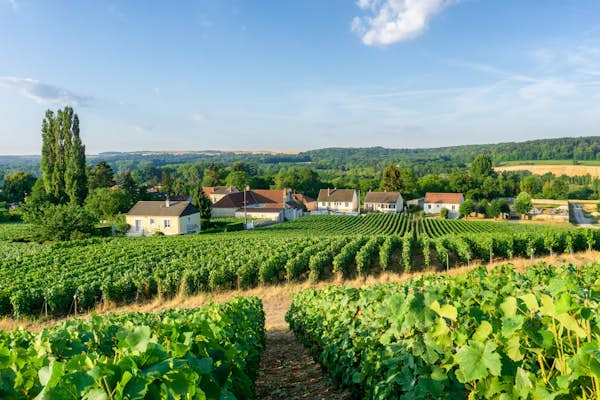
There’s no drink quite like champagne. Popping open a bottle instantly conjures up images of celebration and glamor and makes even an ordinary occasion something special.
A trip to the region is of course a must for wine lovers and gastronomes, but it also offers a welcome break in nature as you drive past sloping vineyards to visit domains and explore charming villages along the way.
Explore the world in comfort with the latest travel insight from our weekly newsletter delivered to your inbox.
If you’re traveling from Paris, Champagne makes an easy day trip – you can reach Reims in 45 minutes and Épernay in just over an hour. But with so many domains dotted around the two towns and the beautiful countryside, you can easily fill a long weekend with endless champagne tastings, tours and activities for a rich introduction to the winemaking process and the fascinating history of the region.
These are the top eight things to do in Champagne, including plenty of suggestions for which domains to visit.
 Famous names like Moët & Chandon offer tours of their historic cellars © JRJfin / Shutterstock
Famous names like Moët & Chandon offer tours of their historic cellars © JRJfin / Shutterstock
1. Take a tour of the big-name champagne houses
While you might not be able to take a look inside some of Champagne’s most prestigious houses (Krug and Dom Pérignon are both closed to the public) you can still enjoy a taste, literally, of some of the world’s most famous champagnes. Ruinart, Pommery and Veuve Clicquot, located just by Reims, or Bollinger, Moët & Chandon and Perrier-Jouët, if you’re staying in Épernay, all open their doors to visitors for tours (in English or French) of their historic cellars.
Planning tip: With so many champagne houses to choose from, it can be hard to know which to pick. Taking a look at any extra highlights on the tour might help you decide which to prioritize.
Ruinart will take you down to the deepest and most impressive hand-dug chalk tunnels (or crayères) in the region. At Perrier-Jouët you can visit the largest private collection of French art nouveau in Europe; if you want to get out into nature, Veuve Clicquot also offers vineyards tours. And over at Pommery, you’ll find a subterranean contemporary-art exhibition on display in the chalk pits.
 Amble around the incredibly charming village of Hautvillers © Sergii Zinko / Shutterstock
Amble around the incredibly charming village of Hautvillers © Sergii Zinko / Shutterstock
2. Pay a visit Hautvillers
The incredibly charming Champagne village of Hautvillers was made famous by Dom Pérignon, who carried out his winemaking while overseeing the Abbaye d’Hautvillers.
You can’t visit the abbey as it’s now privately owned by Moët & Chandon, but you can pop into St-Sindulphe church to see Dom Pérignon’s tomb. You can also book guided tours of the village to find out more about its history, or simply amble around, stopping for a glass of champagne, of course, in one of the restaurants or bars.
3. Take a bike ride through the vineyards
Cycling through Champagne’s world-famous vineyards is such a simple activity, but it really does create an unforgettable experience. You don’t have to be a cycling pro – routes suit beginners too – and if you’re worried about tackling those hills, most companies do tours on e-bikes to give you a boost.
Try A la Française Champagne for full-day bike tours (including a stop for a champagne lunch) from Reims, Epernay or Mareuil-sur-Ay; Les Evasions Un Vélo pour la Planète for half-day e-bike tours around the vineyards of Montagne de Reims; or Sacré Wine Tour’s bike and combined bike-and-car tours to explore the history of the region.
4. Don’t forget the smaller champagne houses
It’s fun to visit the larger houses and see behind the scenes of a champagne you’ve probably tasted before, but seeking out some of the lesser-known domains is a great way to support smaller producers and also try something new.
Champagne Vilmart, Champagne Larmandier-Bernier, Champagne Morel and Champagne Lelarge-Pugeot are all family-owned estates that respect the environment through sustainable practices and produce wines in more unusual ways, such as biodynamic farming or an interesting mix of grapes.
Planning tip: Smaller producers don’t have the same space or capacity to run tours like the big-name champagne houses, so it’s best to contact them in advance to check when they’d be able to welcome you.
5. Support Champagne’s women-led wineries
Women have always played a big role in Champagne, from the legendary Lily Bollinger to Veuve Clicquot and Madame Pommery, and a new generation of female winemakers are continuing to lead the way at many of the region’s respected houses.
Champagne Cossy, Piot-Sévillano, Veuve Olivier & Fils, Albert Beerens and Champagne Lamiable are not only houses headed up by women, they’re also taking steps to implement more sustainable ways of wine growing and are happy to welcome visitors curious to find out more.
 Reims Cathedral is an important example of Gothic architecture © Pakin Songmor / Getty Images
Reims Cathedral is an important example of Gothic architecture © Pakin Songmor / Getty Images
6. Visit Reims Cathedral
When you need a break from all that champagne tasting, one of the big sites to visit is Reims Cathedral. Built in the Gothic style, which is why it might remind you of Paris’ more famous Notre-Dame, the 13th-century structure is listed on Unesco’s World Heritage list and is considered one of the most important examples of Gothic architecture in Europe.
Look out for stained-glass windows celebrating Dom Perignon and his role in the history of champagne-making and the statue outside of Joan of Arc, who was beside Charles VII when he was crowned at the cathedral in 1429. It’s free to go inside, or you can book a guided tour.
Detour: Don’t miss Jardin Henri Deneux, which is hidden around the back of the cathedral and makes a great spot for a photo.
7. Get an introduction to champagne at Pressoria
For an easy introduction to champagne, head to Pressoria, a new interactive museum housed in the former pressing room of Pommery.
The idea is to learn about champagne using all five senses, so you’re encouraged to get involved with the exhibition by playing with the touch screens, sniffing different grape varieties and ending with a champagne tasting. It’s a good activity for older kids too, as the hands-on activities should keep them engaged.
Planning tip: Pressoria is surrounded by champagne houses, including Perrier-Jouët and the Bollinger-owned Ayala, so you could add a visit onto an afternoon of tastings and tours. If you’ve made Épernay your base, then the museum is also just a 10-minute drive away.
8. Delve deeper at the Museum of Champagne Wine and Regional Archaeology
Housed in the stunning Château Perrier, the former private mansion of Charles Perrier of Perrier-Jouët, the Musée du vin de Champagne et d’Archéologie régionale offers a deeper look at the history of la Champagne, the region, and le champagne, the drink.
It really does start at the beginning, with an introduction to the geology and archaeology of Champagne, before taking you to the arguably more fun part, which is the story of how the drink was created and its reputation during the glamorous Belle Époque.



